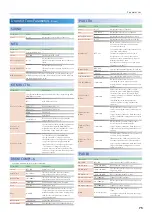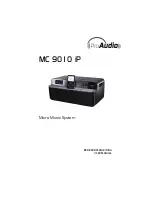
61
ZEN-Core Tone Parameter
(Z-Core)
SOUND
Parameter
Value
Explanation
Level
0–127
Adjusts the overall volume of the tone
Pan
L64–0–63R
Specifies the pan of the tone. “L64” is far left,
“0” is center, and “63R” is far right.
Soft Level Sens
0–100
Specifies the amount of volume change
that occurs when you operate the soft pedal
(CC#67).
This is effective when specified for piano
sounds.
Priority
This determines how notes will be managed when the maximum
polyphony is exceeded.
LAST
The last-played voices will be given priority,
and currently sounding notes will be turned
off in order, beginning with the first-played
note.
LOUDEST
The voices with the loudest volume will be
given priority, and currently sounding notes
will be turned off, beginning with the lowest-
volume voice.
Analog Feel
0–127
Applies time-varying change to the pitch
and volume of the tone that is producing
sound, adding a sense of variability. As you
increase this value toward the maximum,
the variability becomes greater, producing
instability.
Mono/Poly
Specifies whether the tone will play polyphonically (POLY) or
monophonically (MONO). The “MONO” setting is effective when
playing a solo instrument tone such as sax or flute.
MONO
Only the last-played note will sound.
POLY
Two or more notes can be played
simultaneously.
Coarse Tune
-48–+48 [semitone]
Adjusts the pitch of the tone’s sound up or
down in semitone steps (+/-4 octaves).
Fine Tune
-50–+50 [cent]
Adjusts the pitch of the tone’s sound up or
down in 1-cent steps (+/-50 cents).
Octave Shift
-3–+3
Adjusts the pitch of the tone’s sound up or
down in units of an octave (+/-3 octaves).
Stretch Tune Depth
OFF, 1–3
This setting allows you to apply “stretched
tuning” to the tone (Stretched tuning is a
system by which acoustic pianos are normally
tuned, causing the lower range to be lower
and the higher range to be higher than the
mathematical tuning ratios would otherwise
dictate.). With a setting of “OFF,” the tone’s
tuning will be equal temperament. A setting
of “3” will produce the greatest difference in
the pitch of the low and high ranges.
The diagram shows the pitch change relative
to equal temperament that will occur in the
low and high ranges. This setting will have
a subtle effect on the way in which chords
resonate.
1
2
3
OFF
2
1
OFF
3
High note range
Pitch difference from
equal temperament
Parameter
value
Low note range
Legato Switch
OFF, ON
This is effective when Mono/Poly is set to
MONO and Legato Switch is turned ON. When
you press the next key while still holding
down the previous key (legato performance),
the pitch changes smoothly. The way in
which the change occurs depends on the
Legato Retrigger Interval.
Parameter
Value
Explanation
Legato Retrigger
Interval
0–12, OFF
When LegatoSwitch is enabled and you play
legato, this specifies whether retriggering
occurs (0–12) or does not occur (OFF).
If this is off, only the pitch of the currently-
sounding tones changes according to the
pitch of the key.
If this is set to 1–12, retriggering occurs
smoothly when the pitch difference during
legato performance exceeds the specified
value.
For example, if this is set to 4, and using C4
as the reference pitch, playing notes Db4–
E4 legato will change only the pitch without
retriggering, but playing the F4 note (which
is five semitones away from C4) legato will
retrigger F4.
When F4 is retriggered at this time, F4 now
becomes the reference pitch.
If this is set to 0, each note is retriggered
every time regardless of the pitch difference.
For acoustic-type sounds in particular, an
unnatural impression can occur if only the
pitch is changed, so you’ll need to adjust the
Legato Retrigger Interval.
Portamento Switch
OFF, ON
Specifies whether the portamento effect will
be applied (ON) or not (OFF).
* Portamento is an effect which smoothly changes
the pitch from the first-played key to the next-
played key. By applying portamento when
the Mono/Poly parameter is “MONO,” you can
simulate slide performance techniques on a
violin or similar instrument.
Portamento Mode
Specifies the performance conditions for which portamento will be
applied.
NORMAL
Portamento will always be applied.
LEGATO
Applies portamento only when you play
legato (i.e., when you press the next key
before releasing the previous key).
Portamento Type
Specifies the type of portamento effect.
RATE
The time it takes will depend on the distance
between the two pitches.
TIME
The time it takes will be constant
Portamento Start
When another key is pressed during a pitch change produced by
portamento, a new pitch change will begin. This setting specifies the
pitch at which the change will begin.
Pitch
Starts a new portamento when another key is
pressed while the pitch is changing.
C5
D4
C4
press D4 key
Pitch
Time
press C4 key
press C5 key
NOTE
Portamento will begin from the pitch where
the current change would end.
C5
D4
C4
press D4 key
Pitch
Time
press C4 key
press C5 key
Portamento Time
0–1023
Specifies the time taken for the pitch to
change when playing portamento. Higher
settings will cause the pitch change to the
next note to take more time.
Parameter List
















































